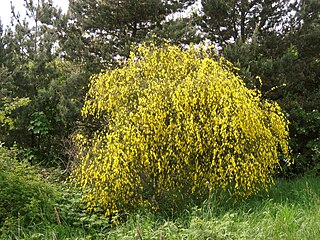
A shrub is a small-to-medium-sized perennial woody plant. Unlike herbaceous plants, shrubs have persistent woody stems above the ground. Shrubs can be either deciduous or evergreen. They are distinguished from trees by their multiple stems and shorter height, less than 6–10 m (20–33 ft) tall. Small shrubs, less than 2 m (6.6 ft) tall are sometimes termed as subshrubs. Many botanical groups have species that are shrubs, and others that are trees and herbaceous plants instead.

Honeysuckles are arching shrubs or twining vines in the family Caprifoliaceae, native to northern latitudes in North America and Eurasia. Approximately 180 species of honeysuckle have been identified in North America and Eurasia. Widely known species include Lonicera periclymenum, Lonicera japonica and Lonicera sempervirens. L. japonica is an aggressive, highly invasive species considered a significant pest on the continents of North America, Europe, South America, Australia, and Africa.

The Caprifoliaceae or honeysuckle family is a clade of dicotyledonous flowering plants consisting of about 860 species in 42 genera, with a nearly cosmopolitan distribution. Centres of diversity are found in eastern North America and eastern Asia, while they are absent in tropical and southern Africa.

Lonicera morrowii, the Morrow's honeysuckle, is a deciduous honeysuckle in the family Caprifoliaceae, native to Japan, Korea, and Northeast China. It is a shrub, reaching a height of 2–2.5 m, with oblong leaves 4–6 cm long. It leafs out quite early in the spring, and in North America is commonly the first deciduous shrub with foliage in March. The flowers are white to pale yellow, and the fruit is a dark red berry 7–8 mm diameter containing numerous seeds. The berries, while eaten frequently by birds, are considered poisonous to humans. It is colloquially called "bush honeysuckle" in the United States, and is considered an invasive species.

The Sheffield Botanical Gardens are botanical gardens situated off Ecclesall Road in Sheffield, England, with 5,000 species of plants in 19 acres (77,000 m2) of land.

Lonicera etrusca is a species of honeysuckle known by the common name Etruscan honeysuckle. It is native to Southern Europe, Western Asia and North Africa and it is known elsewhere, including the Pacific Northwest of North America, as an introduced species where it has escaped cultivation. It is kept in gardens as an ornamental plant.

Weigela is a genus of between six and 38 species of deciduous shrubs in the family Caprifoliaceae, growing to 1–5 m (3–15′) tall. All are natives of eastern Asia. The genus is named after the German scientist Christian Ehrenfried Weigel.
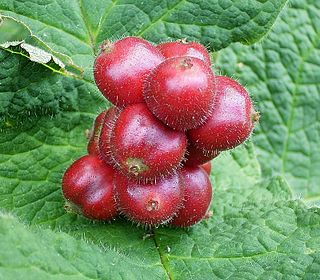
Triosteum, commonly known in American English as horse-gentian or, less commonly, feverwort, and, in Standard Chinese as 莛子藨属, is a genus of flowering plants belonging to the family Caprifoliaceae. A genus of six species in total, it has three species native to North America, and three more in eastern Asia.

Lonicera caerulea, also known by its common names blue honeysuckle, sweetberry honeysuckle, fly honeysuckle, blue-berried honeysuckle, or the honeyberry, is a non-climbing honeysuckle native throughout the cool temperate Northern Hemisphere in countries such as Canada, Japan, Ukraine, and Poland.
Bush honeysuckle is a common name for several plants and may refer to:

Lonicera involucrata, the bearberry honeysuckle, bracted honeysuckle, twinberry honeysuckle, Californian Honeysuckle, twin-berry, or black twinberry, is a species of honeysuckle native to northern and western North America.
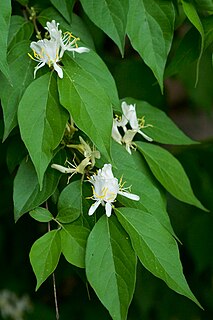
Lonicera maackii, the Amur honeysuckle, is a species of honeysuckle in the family Caprifoliaceae that is native to temperate western Asia; specifically in northern and western China south to Yunnan, Mongolia, Primorsky Krai in southeastern Siberia, Korea, and, albeit rare there, central and northern Honshū, Japan.

Lonicera sempervirens is a species of honeysuckle vine native to the eastern United States which is known for its reddish flowers.

Lonicera nitida is a species of flowering plant in the honeysuckle family. In English, it is sometimes given the common names box honeysuckle or Wilson's honeysuckle. It is widely used as a low hedging plant, and for topiary. It is also a popular low-maintenance ground cover plant for urban landscaping.

Lonicera canadensis is a flowering deciduous, perennial, phanerophytic shrub which is monoclinous and grows 1–2 m tall. It is the only member of its genus with hairless leaf structures. It typically flowers from the last week of April until the third or fourth week of May. Fruit appears approximately the first week of June until the first week of August. The fruit is fed upon by a variety of avian frugivores including the American Robin and Northern Cardinal.

Diervilla lonicera, commonly referred to as northern bush honeysuckle, low bush honeysuckle, dwarf bush honeysuckle, or yellow-flowered upright honeysuckle, is a deciduous shrub native to the northeastern United States and Canada. Its specific epithet, lonicera refers to its similarity in appearance to the true honeysuckles, genus Lonicera. It attracts bumblebees and is an important source of nectar for them.
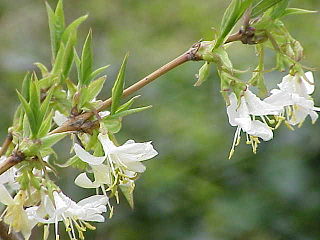
Lonicera fragrantissima is a species of flowering plant in the honeysuckle family Caprifoliaceae, known by the common names winter-flowering honeysuckle, fragrant honeysuckle, kiss-me-at-the-gate, and sweet breath of spring. It is native to China and has been an introduced species to other parts of the world. It was brought to the attention of western gardeners by Scottish plant hunter Robert Fortune, who was plant hunting in China for the Royal Horticultural Society. Fortune introduced Lonicera fragrantissima to England in 1845, and a few years later it was introduced to the United States. In 1853 the editor of American gardening magazine The Horticulturist wrote that the previous year he had been sent a specimen from a plant that had been flowering in the gardens of Hatfield House, the Marquess of Salisbury's stately home in Hertfordshire. The first mention of a specimen for commercial sale in an American plant catalogue is in 1860.

Lonicera utahensis is a species of flowering plant in the honeysuckle family known by the common names Utah honeysuckle, red twinberry, and fly honeysuckle. It is native to western North America from British Columbia, Washington (state), and Oregon, east to Alberta and Montana and south through the Rocky Mountains to Arizona and New Mexico.
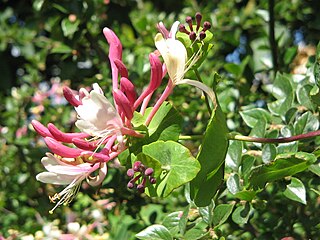
Lonicera caprifolium, the Italian woodbine, perfoliate honeysuckle, goat-leaf honeysuckle, Italian honeysuckle, or perfoliate woodbine, is a species of perennial flowering plants in the genus Lonicera of the family Caprifoliaceae. It is native to parts of Europe, and naturalised in South East Britain and northeastern North America. It can readily be distinguished from Europe's most common species, Lonicera periclymenum, by its topmost leaves, which are perfoliate as the Latin name suggests. It is a vigorous, deciduous climber growing up to 8 metres. It bears masses of very fragrant, cream-coloured flowers, tinged with pink, appearing in midsummer.

Lonicera × bella, known as Bell's honeysuckle and showy fly honeysuckle, is a hybrid species of flowering plant in the family Caprifoliaceae. It was first described by Hermann Zabel in 1889. Zabel reported that he grew it in cultivation from seeds obtained from a plant of Lonicera morrowii, but that its appearance suggested the influence of L. tatarica. It has escaped from cultivation and become an aggressive invasive species in central and eastern parts of the United States.





















